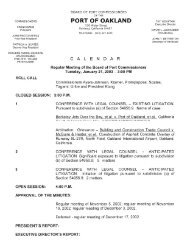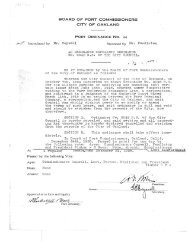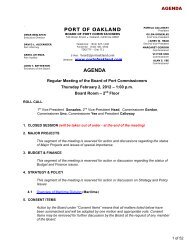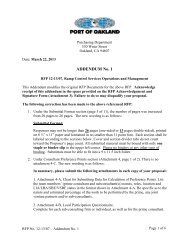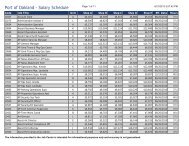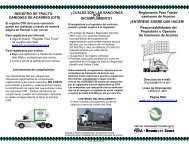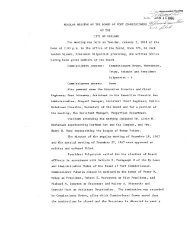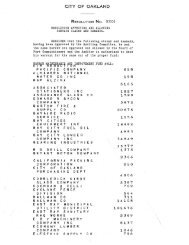Port-Wide Sewer System Management Plan(SSMP) - Port of Oakland
Port-Wide Sewer System Management Plan(SSMP) - Port of Oakland
Port-Wide Sewer System Management Plan(SSMP) - Port of Oakland
You also want an ePaper? Increase the reach of your titles
YUMPU automatically turns print PDFs into web optimized ePapers that Google loves.
3. The facility has caused or contributed to collection system blockages resulting in<br />
maintenance requirements or sewage spills.<br />
Each FSF with a grease interceptor is required through their WDP and EBMUD Ordinance<br />
No. 311A-03 to clean their interceptor on a regular basis to ensure its proper operation. At a<br />
minimum, each interceptor must be cleaned once every three months and the grease must<br />
be disposed <strong>of</strong> by an EBMUD approved grease hauler (see Section 8.2.2).<br />
The <strong>Port</strong> is becoming very proactive in requiring new FSFs in the airport to install large<br />
grease interceptors. A large grease interceptor for the new Chile’s Too was recently<br />
installed. Additionally, grease interceptors will be constructed to service two new food<br />
courts and the new Silver Dragon restaurant. This approach is consistent with the EBMUD<br />
interceptor requirements and the intent <strong>of</strong> the GWDRs.<br />
8.2.5 Best <strong>Management</strong> Practices<br />
EBMUD has developed nine separate BMPs related to FOG. The BMPs are summarized in<br />
Table 8.2 and are developed primarily for FSFs, which are the primary discharges <strong>of</strong> FOG<br />
within the <strong>Port</strong> service area. Certain BMPs, however, do have a more universal<br />
applicability. A flyer containing the information presented in Table 8.2 is also available on<br />
the EBMUD website.<br />
8.2.6 Inspection and Enforcement Procedures<br />
In order to avoid redundancy and save time and cost to the <strong>Port</strong>, FOG Control <strong>Plan</strong><br />
recommends that all FOG inspection and enforcement actions be completed by EBMUD<br />
through their existing FOG control program. A partnership with <strong>Port</strong> personnel may be<br />
required at the Airport and Maritime facilities since security clearance requirements could<br />
hinder EBMUD personnel from performing this function. <strong>Port</strong> staff could take on<br />
responsibility for inspecting facilities at the Airport or Maritime areas, or escort EBMUD staff<br />
on these inspections.<br />
8.2.6.1<br />
Inspection<br />
The inspection procedures are based on a system-wide monitoring approach with<br />
increased monitoring targeted at known “hot spot” areas, as summarized below:<br />
• Hot spot areas. For this group <strong>of</strong> inspections, the <strong>Port</strong> identifies the locations <strong>of</strong><br />
grease-related SSOs or blockages to EBMUD. EBMUD then schedules targeted<br />
inspections for dischargers upstream <strong>of</strong> the “hot spot” to identify the most likely<br />
source <strong>of</strong> the problem. Accelerated interceptor maintenance schedules or interceptor<br />
installations are then required as necessary to mitigate the issue.<br />
• Non-hotspot areas. Inspection is performed routinely at all FSFs during the permit<br />
period (at least once during each permit period). EBMUD inspectors verify that<br />
required routine maintenance for grease traps and interceptors is being performed in<br />
May 2010 8-5<br />
pw://Carollo/Documents/Client/CA/<strong>Port</strong> <strong>of</strong> <strong>Oakland</strong>/8239A00/Deliverables/Ch08 (FinalA)



